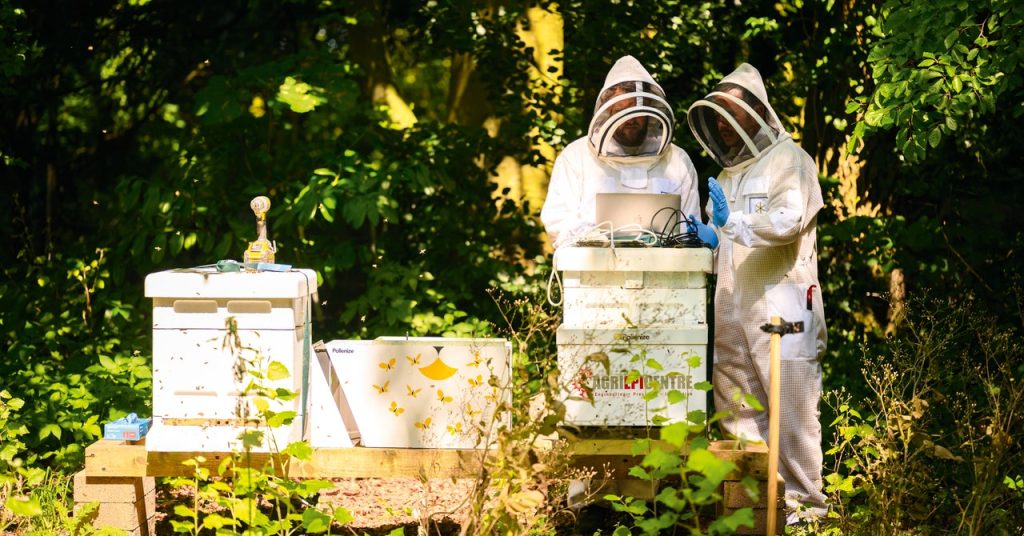The Battle Against Invasive Asian Hornets: Pollenize’s AI-Powered Solution
A Pharmacy for Bees
In the heart of Plymouth, a unique pharmacy illuminates the night with its green glow. Instead of dispensing medication, this establishment, owned by Pollenize, offers a different kind of remedy: seeds. Jars filled with various wildflowers line the shelves, ready to help combat the challenges faced by honeybees in Britain.
Diagnosing and Treating Bee Deficiencies
Pollenize, a social enterprise, leverages data analysis to identify and address issues affecting honeybees. With threats like habitat loss, climate change, pesticides, and the looming danger of invasive hornets, the company has developed innovative solutions. They began by creating a tracking tool that maps wildflower loss and recommends AI-generated seed packets. Later, they introduced beehive cameras to study how these factors influence foraging patterns. Now, they’ve shifted their focus to preventing an invasion.

Beekeepers need to check hive frames for pests such as varroa mites and to look for queens preparing to set up a new colony. Photograph: Chris Parkes
The Asian Hornet Threat
Since the Asian hornet first infiltrated France in 2004, likely as a stowaway on a cargo ship from China, this invasive species has become a nightmare for European beekeepers. Nicknamed “murder hornets” due to their ability to overwhelm local ecosystems, a single Asian hornet can devour up to 50 native bees per day. Although Britain has managed to keep the scale of the Asian hornet invasion at bay compared to its European neighbors, sightings on English shores are increasing. In 2023, there were 76 confirmed Asian hornet sightings in the UK, a significant rise from the 23 recorded between 2016 and 2022.
The Challenge of Nest Detection
Volunteer teams are now actively searching for Asian hornets arriving on British soil. However, as Elmes points out, detection is only the beginning. The real challenge lies in tracking the hornet back to its nest to eradicate the colony. “If something can automate and help us, it will shave off time,” he explains. This is the driving force behind Pollenize’s latest endeavor—a network of AI-powered camera bait stations designed to detect and track Asian hornets.

Beekeeper Shelley Glasspool tends to a hive on the roof of the Marine Biological Association in Plymouth. Photograph: Chris Parkes
The Impact on Native Bees
Asian hornets are indiscriminate eaters, consuming everything from bees and blowflies to fishing bait and barbecue food. Their presence alone weakens native bee populations by triggering “foraging paralysis.” As Christie explains, “Bees go into a defensive mode when there are hornets attacking their home. If you’re in a castle under attack, you go into siege mentality.” Bees will cease cleaning their hive and gathering nectar and water, ultimately leading to the collapse of the colony.
The Fightback in Jersey
In Jersey, which finds itself at the forefront of the Asian hornet invasion, Christie has been spearheading the counterattack. Public awareness campaigns encourage people to submit photos of suspected hornets, identifiable by their orange faces, yellow-tipped legs, and imposing size. Courageous volunteers have started constructing bait stations using shallow dishes filled with dark beer or sugar water. When an Asian hornet lands, volunteers attach tinsel streamers to its back, enabling them to track its flight path and locate its nest. A rule of thumb suggests that for every minute an Asian hornet spends away from a bait station between feeding visits, the nest is approximately 100 meters away.
Accelerating Nest Location with AI
Locating an Asian hornet nest using traditional methods takes an average of 50 hours. However, machine learning has the potential to expedite this process. “Can we use AI to predict where the nest location is so we can find nests quicker, destroy them quicker, and reduce the ecological damage?” Elmes asks. Pollenize is collaborating with French tech giant CapGemini on Hornet AI, a network of automated camera bait stations that employs an object detection algorithm trained on 5,000 images of Asian hornets.

This Asian hornet station in the Associated British Port of Plymouth attracts the hornets, IDs them with its AI cameras, and alerts local authorities. Photograph: Chris Parkes
The Hornet AI Prototype
The prototype bait station utilizes a vaporizer to emit an irresistible attractant for Asian hornets. When a hornet approaches the bait station to feed, the camera detects it and marks it with a physical colored sticker. The software then monitors the hornet’s departure direction and measures the duration of its absence, significantly reducing the time required to pinpoint the nest’s location. “It works like CCTV,” Elmes remarks.
Scaling Up Hornet AI
In December 2023, Pollenize secured a grant from Innovate UK to expand Hornet AI. The UK’s National Bee Unit will test the units in southeast England, aiming to enhance nest tracking efficiency by 80 percent. However, Elmes emphasizes the urgency of the situation. “If we’re on it next year, we can keep Asian hornets at bay,” he states. “If we don’t win next year, it’s going to be exponential.”
This article appears in the May/June 2024 issue of WIRED UK magazine.

5 Comments
Murder hornets? More like underdog story villains facing bee bravery!
Honeybees are not just making honey; they’re fighting off actual monsters, talk about a plot twist!
In a showdown of buzz versus brawn, honeybees are not going down without a fight!
In the epic saga of nature, bees are gearing up for a blockbuster battle against the infamous murder hornets!
It’s like an insect gladiator arena out there!